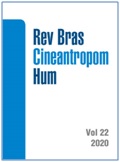¿EXISTEN DIFERENCIAS ENTRE LA CARGA DE UN TEST DE CAPACIDAD ANAERÓBICA Y UN TEST DE AGILIDAD EN JUGADORES DE BALONCESTO?
DOI:
https://doi.org/10.1590/1980-0037.2020v22e59837Resumen
Introducción: El baloncesto es un deporte de equipo con desplazamientos rápidos, cambios en la dirección y, en ocasiones, se le acompañan saltos. Para analizar este rendimiento, el punto de partida del análisis toma como referencia la propia competición. El objetivo de este trabajo fue conocer las demandas de los jugadores en los test seleccionados, buscar diferencias entre categorías y conocer si había alguna relación entre las distintas pruebas. Método: La muestra está conformada por 2 equipos (sub-14, sub-16; n=24) que fueron equipados con un dispositivo inercial WimuR. Los test seleccionados fueron 2 test de agilidad y un test de capacidad anaeróbica láctica. Se seleccionaron variables neuromusculares y cinemáticas. Se realizó un análisis descriptivo, uno inferencial y uno de correlación entre variables. Resultados: Una vez descritos los requerimientos, no existen diferencias significativas entre las variables cinemáticas en función de la categoría de la muestra, aunque sí existe relación entre las variables cinemáticas y neuromusculares de los diferentes test. Discusión: A menudo, se suele afirmar que los test de capacidad son los test que mayor fatiga provocan en el deportista. Por este motivo, se realizó un análisis en el que se comparaba un test de capacidad anaeróbica láctica con un test de agilidad en sus dos versiones. Conclusiones: Los resultados obtenidos pueden facilitar la labor y el tiempo de evaluación de test de condición física, pues realizando pruebas de menor requerimiento se podrían conocer los resultados del deportista en una prueba de capacidad ahorrándole enfrentarse ante una situación de esfuerzo máxima, una posible lesión y economizando el tiempo de entrenamiento.
Citas
Zarić I, Dopsaj M, Marković M. Match performance in young female basketball players: relationship with laboratory and field tests. Int J Perf Anal Sport 2018;18(1):90-103.
Peyer KL, Pivarnik JM, Eisenmann JC., Vorkapich M. Physiological characteristics of National Collegiate Athletic Association Division I ice hockey players and their relation to game performance. J Strength Cond Res 2011;25(5):1183-1192.
Sarmento H, Marcelino R, Anguera MT, Campaniço J, Matos N, Leitão JC. Match analysis in football: a systematic review. J Sports Sci 2014;32(20):1831-1843.
Ziv G, Lidor R. Vertical jump in female and male basketball players-A review of observational and experimental studies. J Sci Med Sports 2009;13(3):332-9.
Jakovljevic ST, Karalejic MS, Pajic ZB, Macura MM, Erculj FF. Speed and agility of 12 and 14 years old elite male basketball players. J Strength Cond Res 2012;26(9):2453-2459.
Gomes JH, Rebello-Mendes R, Almeida MBD, Zanetti MC, Leite GDS, Ferreira Júnior AJ. Relationship between physical fitness and game-related statistics in elite professional basketball players: Regular season vs. playoffs. Motriz 2017;23(2):1-7.
Mancha D, Ibáñez, SJ, Reina M, Antúnez A. Comparative study about aerobic and anaerobic endurance for basketball players based on the training methodology. Sport TK 2017;6(1):183-192.
Ibáñez SJ, Sampaio J, Feu S, Lorenzo A, Gómez MA, Ortega E. Basketball game-related statistics that discriminate between teams’ season-long success. Eu J Sport Sci 2008;8(6):369-372.
Green MR, Pivarnik JM, Carrier DP, Womack CJ. Relationship between physiological profiles and on-ice performance of a National Collegiate Athletic Association Division I hockey team. J Strength Cond Res 2006;20(1):43-46. Delextrat A, Cohen D. Physiological testing of basketball players: toward a standard evaluation of anaerobic fitness. J Strength Cond Res 2008;22(4):1066-1072.
McGill SM, Andersen JT, Horne AD. Predicting performance and injury resilience from movement quality and fitness scores in a basketball team over 2 years. J Strength Cond Res 2012;26(7):1131-1739.
Ato M, López JJ, Benavente A. Un sistema de clasificación de los diseños de investigación en psicología. Ana de Psi 2013;29(3):1038-1059.
Barreira P, Robinson MA, Drust B, Nedergaard N, Raja Azidin RMF, Vanrenterghem J. Mechanical Player Load™ using trunk-mounted accelerometry in football: Is it a reliable, task-and player-specific observation? J Sports Sci 2016,35(17);1-8.
Cunniffe B, Proctor W, Baker JS, Davies B. An evaluation of the physiological demands of elite rugby union using global positioning system tracking software. JStrength Cond Res 2009;23(4):1195-1203.
Bloomfield J, Polman R, O’donoghue P, McNaughton LARS. Effective speed and agility conditioning methodology for random intermittent dynamic type sports. J Strength Cond Res 2007;21(4):1093-1100.
Ibáñez SJ, Sáenz-López P, Gutiérrez A. Test anaeróbico SIG/ANA específico sobre el terreno, para jugadores de baloncesto (Abstract). Congreso Científico Olímpico 1995. Bioquímica, Fisiología del Ejercicio y Medicina del Deporte. Málaga: 1995, p. 209-216.
Cubo S. La investigación experimental. In Cubo S, Marín B, Ramos JL, organizadores. Métodos de investigación y análisis de datos en ciencias sociales y de la salud. Madrid: Ediciones Pirámide; 2011. p. 235- 328.
Pardo A, Ruiz, MA. SPSS 11. Guía para el análisis de datos. Madrid: Mc Graw Hill; 2002.
Krustrup P, Mohr M, Steensberg A, Bencke J, Kjaer M, Bangsbo J. Muscle and blood metabolites during a soccer game: implications for sprint performance. Med Sci Sports Exerc 2006;38(6):1165-1174.
Calleja-Gonzalez J, Leibar X, Terrados N. Análisis de la concentración de lactato en competición en jugadores internacionales junior de baloncesto. Arch Med Dep 2008; 25(123):11-18.
Walker S, Turner A. A one-day field test battery for the assessment of aerobic capacity, anaerobic capacity, speed, and agility of soccer players. Strength Cond 2009;31(6):52-60.
Salinero JJ, González-Millán C, Ruiz-Vicente D, Abián-Vicén J, García-AparicioA, Rodríguez-Cabrero M, et al. Valoración de la condición física y técnica en futbolistas jóvenes. Int J Med Sci Phys Act Sport 2013;13(50):401-418.
Sekulic D, Pehar M, Krolo A, Spasic M, Uljevic O, Calleja-González J, et al. Evaluation of Basketball-Specific Agility: Applicability of Preplanned and Nonplanned Agility Performances for Differentiating Playing Positions and Playing Levels. J Strength Cond Res 2017;31(8):2278-2288.
Descargas
Publicado
Número
Sección
Licencia

Direitos Autorais para artigos publicados nesta revista são do autor, com direitos de primeira publicação para a revista. Em virtude da aparecerem nesta revista de acesso público, os artigos são de uso gratuito, com atribuições próprias, em aplicações educacionais e não-comerciais, desde que seja dada a atribuição. Esta obra foi licenciada com uma Licença Creative Commons Atribuição 4.0 Internacional - CC BY


